Organic Wine
by Vicky Hayward

Pictures: Rafael Vargas, courtesy of the Spanish Institute for Foreign Trade (ICEX)
In the three years since I wrote this article organic winemaking has taken off in a big way. The number of bodegas making organic wines has doubled and there are a total of 16,037 hectares (39,627 acres) of registered organic vineyards, with the largest cluster in Murcia region. Contacts for the regional bodies who supervise organic farming and keep a complete register of producers are given on the Ministry of Agriculture, Fishing and Food website: www.mapya.es
In 1979 Spain’s first certified organic vines were planted in a small patch of vineyard close to Catalonia’s cava capital, Sant Sadurní d’Anoia. At the time Josep María Albet i Noya ran the vineyard alone with part-time seasonal help, selling the wine in bulk for bottling in other Penedés bodegas. Today, the bodega has three oenologists and makes two dozen wines from sixteen varieties of organically grown grapes. Every year the wines, which range from a lightly oaked varietal white made from the native Xarel-lo grape to a Cabernet Sauvignon Crianza and, of course, a cava, win a clutch of regional, national and international prizes. “There is no reason why wines made from organic grapes cannot compete in quality with the very best of the other wines on the market,” comments Josep María. In the twenty years it has taken for Albet i Noya to find its place as a premier bodega, organic winemaking has spread to sixteen other wine regions and over eighty wineries of all kinds — small family operations, cooperatives, and renowned bodegas. Each wine has a clear personality closely tied to its terroir. But all the winemakers share the belief that good organic growing is more than an environmental issue; it also gives the potential for superb wine.
On a bitter January day green spikes of rye, vetch and rye grass are breaking through the cold earth between the rows of vines planted below Albet i Noya’s farmhouse-bodega. The vines here are trained high on wire trellises to give maximum exposure to the sun and air. Later in the winter the manuring crops will be ploughed up so the vines can make the most of the light spring rains and, after mulching down with vine prunings, they will be dug into the soil with home-made compost.
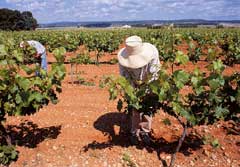
Much of the vineyard work here is done laboriously by hand: spring pruning, pinching out the vines’ leaves as the fruit ripens and harvesting, too, to prevent insects, animals and dirty fruit slipping into the crushing hopper from which the grape musts are piped off to small stainless steel deposits for fermentation by variety and vineyard. The red wines and some of the whites are at least partially fermented on the grapeskins. After racking, blending and wood-ageing, which varies for each wine and vintage, they are gently filtered through cellulose and bottled with an inert gas below the cork. “It is essential to keep sulphur levels low,” comments Josep y María.
Research is an integral part of Albet i Noya’s winemaking. A small area of the vineyard below the bodega is set aside for trials with pruning, trellising and vine-training techniques. Elsewhere fourteen grape varieties — some of them neglected native grapes, others imported — are being grown as part of a five year project, monitored by the Catalan Institute of Vines and Wine (INCAVI), to test their winemaking potential. Each grape is being vinified two ways and aged on five woods ranging from cherry to chestnut.
In parallel, the winemaking evolves. New varieties have been planted. “In Australia I fell in love with Syrah so I thought, why not try it?” says José María. “My view is that you only live once, you only have one chance to try things out. It keeps winemaking interesting.” The bodega also now buys in grapes from fifteen organic growers, some of whose vineyards were planted over 70 years ago. In this way production has not only grown; it has also diversified around the Penedés microclimates to make single-vintage Macabeo, Xarel.lo, Tempranillo, Cabernet Sauvignon and Chardonnay varietals as well as blended wines.
Today the restless search for quality is paying off. In 1999 the bodega’s sales, 80% of them abroad, reached 340 million Ptas, part of which is paying for buiding work to double the bodega’s capacity. But Josep i María emphasizes that organic growing is not in itself a commercial end.
For me organic growing is inseparable from making wonderful wines. That, rather than organic growing, is the hard bit.
A Late Start
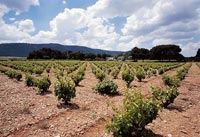
Spain’s southern climate and altitude naturally lend themselves to organic growing. But with the exception of a few notable pioneers — such as Peréz Caramés in El Bierzo, Ca’n Majoral in Mallorca, Gómez Nevado in Cordoba and Dominio de los Pinós in Valencia — most organic bodegas here did not begin producing until the late 1990s.
“Ten years ago Spain was exceptional among the world’s major wine producers in its lack of organic production,” comments Jem Gardner of specialist English wine-merchants Vinceremos. “But in the last few years there has been a real explosion of interest in different regions.”
One can speculate on the reasons for the late start: the association of organic growing with rough country wines; the conspicuous absence of a major national wine scandal; lack of research or information on organic growing; and, as a result, the fear of handling bug invasions without falling back on systemic chemicals.
Another fear was economic viability. In this sense the example of pioneers like Albet i Noya has been decisive. They have showed that organic growing is both cheaper and less risky in Spain than in northern Europe thanks to the natural advantages of climate and, often, altitude.
“I’d say that in Spain organic costs 10-20% more than conventional growing,” comments Josep María. Estimates by makers in the Rioja and Levante go up to 25% — but never as high as 40%, as in some areas of central Europe. But, as Josep María adds, “What is expensive is producing quality, which can cost up to 500% more.”
Nevertheless, at this level of the market too, organic wines have showed they can pay for themselves thanks to their value in international markets.
“It is a very different world to the rest of the wine business,” explains Madeleine Olaechea of Dominio Los Pinos, which began organic winemaking in 1989. “Buyers are not so interested in the region, the label — they want to visit the vineyard, taste the wine and keep in personal contact. But providing they like the wine, they keep coming back for more.”
From Natural to Organic
In fact, alongside that, Spain has a tradition of wines that are virtually free of chemical residues. In areas with a dry continental climate’s freezing winters and blazing summers — for example, Priorato, the Ribera del Duero or Toro — mildew, botrytis and pests like grape caterpillars remain at such low levels that growers have never used more than a minimum number of preventive treatments. The average sulphite levels of Ribera wines today — around 45mg total per litre — fall well within organic maximum levels.

More generally, too, systemic chemical fertilizers and pesticides arrived late in Spain. “Until the 1950s everything here — wheat, barley and vines — was grown the old way, with sulphur or copper if and when you needed it,” explains Felipe Martínez, aged 70, from Muzarabal, in northern Navarra. “Weedkiller began to arrive in the 1950s, but it was another thirty years before the farmers began to buy chemical fertilisers. And then, very quickly, everyone saw that although it helped produce more grapes, their quality was not the same as before.”
While some of Spain’s traditional wines were produced by small-scale growers for local consumption, others were made by renowned bodegas. Estate-bottled vinos de pago (domaine wines) such as Remelluri and Marqués de Vargas in the Rioja, Terras Gauda and Fillaboa in southern Galicia, Pago de Carraovejas or Marqués de Velilla in the Ribera del Duero, come from vineyards that have long been close to organic. Such growing methods give precisely what fine winemakers seek: smaller harvests of high quality grapes expressing the full character of the vine’s variety without the muddied aromas or taste of residual chemicals.
This tradition of natural winemaking was never much commented on, least of all by the makers themselves. Many preferred to let the quality speak for itself or simply took traditional methods for granted. “It was part of our family’s way of life,” says Andreu Oliver, who makes Ca’n Majoral, a Mallorcan wine. “We always grew organically, but certifying wasn’t possible here until 1985 and it didn’t seem anything special.”
Even today, many wines made from organically grown grapes don’t declare their origins. Manuel Valenzuela, who produces Barranco Oscuro, a respected wine from an organic vineyard in the Alpujarras, once commented to Vinum magazine, “I do not use chemical fertilizers because my vineyard will turn into a desert. But I don’t want to go further than that and make a statement — it could produce sectarianism.”
Likewise, Ca’n Majoral doesn’t label all its wine as organic. “Our idea isn’t so much to make and sell an organic wine as to think and work in an organic way and produce a really good wine. There’s a difference.”
But the strength of this tradition meant that once interest was awakened, certified organic growing could implant iself very quickly. The knowledge was there, often for the asking from older farmers who still followed old ways, and there were virtually organic vineyards in many growing areas such as Montilla, Priorato and Navarra, where organic winemaking has quickly settled into DO regions.
Growing Methods: the Mediterranean
Organic vineyard and winemaking methods follow certain clear principles. Soil care is of prime importance to prevent disease and keep the quality of fruit high; vineyard planting is designed to give maximum direct exposure to air and sunlight to give healthy fruit; pruning is designed to sacrifice quantity for quality; new planting favors native varieties or imported ones from similar habitats. At the winemaking stage, careful selection of the grapes during harvesting and bodega hygiene are essential to keep the use of sulphite preservatives after fermentation at a minimum. Spanish guidelines for vinifying wines made from organic grapes have also made it general practise for the grapes’own yeasts only to be used in fermentation, and for stabilization and clarifying to be natural.
But Spain’s geography is such that every grower needs to work out by trial and error how to put these guidelines into practise in their microclimate and terroir.
At one end of the spectrum are the dry southern vineyards. “When we found Fontanares, we knew it was perfect,” says Madeleine Olaechea. She and her husband Manuel, who comes from a Peruvian winemaking family, searched Europe in 1989 for the right site for an organic vineyard. Their journey came to an end at Los Pinos one hundred kilometres inland from Valencia, within its DO growing region.
The vineyard was isolated in a high valley at 600 metres, the soil was a good mix of loam and chalk, and we knew the very low rainfall of around 400 mm a year would give us a very low yield of healthy, high quality grapes.
In this kind of setting, bone-dry for most of the year, organic fertilisers replace manuring cover crops. “They would suck up the little moisture there is and stress the vines,” explains Madeleine. “Instead we use local sheep’s manure and guano in small quantities.”
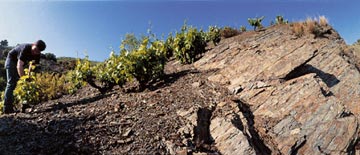
Wine-making is straightforward providing the fruit is scrupulously clean. Sulphur levels here are as low as they can go: 30 mg per litre for reds, and never more than 50 mg for whites. “They are trickier because of the risk of oxidization as the harvested grapes travel to the bodega.” Before fermentation, the whites are cooled to 0°C to help clean the musts and maintain their aromas. The art of making the big, ruby oak-aged reds lies in one-off blending of the vineyard’s varieties: native Monastrell, Macabeo and Malvasía de Valencia with imported Syrah, Merlot, Carignan, Cabernet Franc and Cabernet Sauvignon.
Although the bodega will take another five years to reach its full potential, Dominio Los Pinos has already won prizes in Italy, the UK and France, and was chosen by the magazine Vinum in 1998 as one of Europe’s top ten organic wines.
We have the right growing conditions and varieties to make very good wine. The possibilities will begin to show in two years and after that we can only improve.
The Green North
At the other end of the spectrum are the cooler, wetter vineyards of green northern Spain where growing conditions are closer to those of central Europe. Here higher rainfall allows green manuring but also encourages more disease, for which organic growers need tougher methods than healthy preventive planting and pruning: for example, pheromones to confuse pests sexually and inhibit their reproduction, and Bacillus Thuringienses, a natural bacteria sprayed on to fruit-bearing vines to kill grape caterpillars.
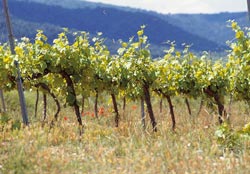
Green Spain’s first organic vineyards to win critical acclaim were those of Bodegas Peréz Caramés, in mountainous El Bierzo on the borderlands of Castile Leon and Galicia. Its wines stood out for their personality and quality long before they were certified as organic in 1995, a decade after organic growing began.
“We use copper and sulphur to deal with mildew and false mildew,” says Pablo Garcá Barredo, the nephew of founder Francisco Peréz Caramés, who took over when his uncle died last year. “But sulphur levels are still only half the organic limits.” They also use organic manuring and plough in the winter weeds in early spring, and pinch out leaves while the fruit is ripening.
Harvesting here is crucial. Every rotten grape must be left on the vine, setting production at about half that of other local vineyards. “We harvest into small crates so the grapes are not squashed, and the crates are washed each time they leave the bodega.”
Winemaking styles here are a mix of new and traditional: red, white and rosé Casar de Santa Inés wines, made from a coupage of imported grape varieties outside DO controls, and Cónsules de Roma, a DO wine made from native Mencía grapes by carbonic maceration (that is, intercellular fermentation of whole grapes in their skins, as in country winemaking in the Rioja). With the vineyard’s reputation and growing methods now well established, the future lies in realizing the wines’ full potential. In 1996 the bodega produced its first Crianza; this year it hopes to release its first Reserva, made from the 1998 vintage.
Navarre: an Organic Heartland
Navarra sits midway between the green north and the dry south. Here organic farming seems to have settled naturally into the rolling landscape between the Pyrenees and the central meseta’s tableland: vineyards are scattered between wheat and asparagus fields, almond and olive groves. Summers can be hot, but cold winter winds blow down from the Pyrenees and up along the Ebro valley, silently spinning the streamlined hilltop windmills which produce half the region’s energy.
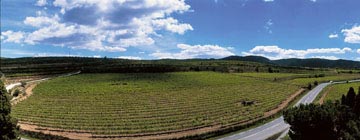
“We are helped by the mixed farming and climate,” says Fernando García Carcar of Bodegas Bagordi, which specializes in fine organic wines. “The switch has been easier than I expected — my father taught me a lot. But you have to be out in the vineyards every day.” He pauses. “Every single day.”
Most of Navarre’s fourteen organic wineries, the biggest regional cluster in Spain, are family operations run by a young winemakers. Bodegas Bagordi, for example, was set up by the García Carcar brothers when they inherited 60 hectares of vineyards around Andosilla, a small town in south-western Navarre. Their purpose-built bodega recyles all the water it uses for authorized irrigation; organic waste goes to the county compost heap.
Bagordi’s newly planted vineyards are angled so that in winter the wind blows along the vines to kill off pests and in summer the sun ripens the grapes equally on both sides of the wire-trained vines. Prunings are dug back into the soil, which is fertilized biennially with locally made organic manure. Sulphur and copper treatments are used a couple of times a year.
Further north, in Valdizarbe, on the Santiago pilgrimage route, Bodegas Martínez Janáriz is typical of the region’s smaller family operations. After training as an oenologist Miguel Angel Martínez redesigned the family’s sheltered valley vineyards around the organic wine he wanted to make. The result, Fidelium, it is a delicious oak-aged red — macerated on the skins for eight days, racked by hand four times and clarified with egg white — and, unusually, has a good local as well as export market. Around half the current annual production of 50,000 litres is bought direct from the cellar bodega, and in 1999, it won second prize in the sommeliers’ annual awards for the best Navarra DO wines. “Here, when people know it’s organic, they prefer it,” comments Miguel Angel’s father, Felipe.
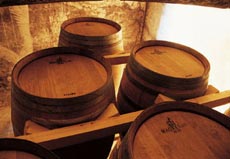
Like all the Navarrese bodegas, Bagordi is also aiming high. Already a quarter of the wines — fermented by variety and vineyard, with a small amount of the harvest pressed to add intensity to the musts — are held back each year with a view to making Crianzas and Reservas. Certainly the 1998 Crianza, based on Tempranillo, softened by Merlot and given body by Garnacha, suggests they have the potential to grow.
“The future will be in Gran Reservas,” comments María Lúz Martínez de Morentín, the oenologist. “At least, that is what the the young wines suggest.”
A number of other Navarrese bodegas, such as Bodegas Ochoa — famed for their moscatel and other varietal wines — seem to agree.
Rioja: Researching the Future
Research in the neighbouring Rioja suggests that the young Navarrese winemakers are right to be aiming high. There are still only half a dozen Riojan certified organic bodegas, but local government research since the early 1990s suggests there may be a huge future here for quality organic vineyards and winemaking.
In the trials, at La Grajera, a research vineyard close to Logroño, scientists are contrasting the effects of conventional and northern organic growing mothods on parallel plots of mature 40-year old Tempranillo vines grown traditionally, en vaso, low and close to the ground. The wines made from them — naturally stabilised and fermented, with 25mg of sulphite added -are also being compared.
“The young wine from organic grapes in the 1999 vintage has magnificent potential,” explains Juan Batista Chavarrí, who runs the research station. “It is very high in varietal aromas and its glycerine content and it shows more natural acidity than the wine from conventionally grown grapes due to tartaric acid levels which develop late in the day. Alongside that we have had very low disease levels which we can deal with by the right soil care and pruning.”
A research-based approach is also being used in bodegas that have switched to winemaking from organic grapes. Viña Ijalbi, who produced their first vintage in 1998, has found pheromones more effective, if also more expensive, than traditional pesticides and endorse American research suggesting that dug-in prunings have a mild herbicidal effect. They are also working with native grape varieties. Juan Carlos Sancha González, who manages the bodega, has published a university study of 44 rarely planted native varieties of which one, Graciano, until recently only used for blending, is being used by Ijalbi to make a big, toasted red organic wine with dry finesse. González also points to Maturrana Tinta y Blanca and Tempranillo Blanco as grapes with a future for makers of fine organic wines.
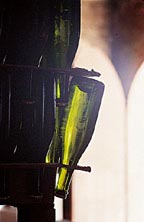
Sancha describes Ijalbi’s philosophy as “an integrated vision of long-term quality.” You could also call it a blend of modern and traditional wisdom. The bodega has recently been adapted to ISO 14001 standards for environmental-friendly management. Musts are gravity-led into fermenting vats, and the wines are aged in cellars with minimum lighting before being filtered through cellulose and bottled in anti ultra-violet glass with lead-free tin caps. A part of the organically grown grape harvest is trodden by foot to give a young red, Solferino, made by traditional carbonic maceration in huge temperature-controlled fermentation tanks.
At the other end of the scale, the Rioja’s organic bodegas include its largest cooperative, Viñedos de Aldeanueva. Here a study of the growing potential of its 600 members’ vineyards in the mid-1990s identified some 96 plots, many small-scale vineyards, as suitable for organic growing; the owners were offered the back-up of the cooperative’s agronomist and a premium payment on the right quality grapes to encourage them.
“Generally the organically grown grapes are smaller, harder and receive a better evaluation for alcohol content, color, sugar and acidity,” comments Marío Esquerro, who cares for the vineyards. “The most interesting and perhaps unexpected result is that in some cases the organic growers have had less disease problems.”
Now the seven growers in the scheme whose organic harvests make some 80,000 litres of wine called Azabache, or Jet, are extending the area of organic vineyards. Currently the wine is sold young, with absolutely no sulphites added in the bodega, , although there are plans to make Crianzas and Reservas. On the label runs a quote from Victor Hugo: “It is extremely sad to think that, while nature is talking, humankind does not listen.”
The South: Terroir Whites
Away from the best-known growing regions, organic growing is already showing another spin-off effect: winemakers are exploring the accentuated character of their grapes, both old and new, to make wines that float free of local tradition and find their own one-off personality.
In Montilla’s rolling hills, to the south of Cordoba, Bodega Francisco Robles is using organically grown Pedro Ximénez grapes to make Piedra Luenga, one of the region’s light, fresh new-generation white wines. After a trial vintage in 1998, last year’s wine was sold out — mainly to Japan — before the harvest began. This year the bodega will be making wine from grapes bought in from seven registered growers to meet demand, and paying a 40% premium on local grape prices to make it worth their while.
“We have been able to graft organic certification on to family vineyards using natural growing methods as long as anyone can remember,” says Francisco José Robles, the third generation of his family to work in the bodega.
But there is a third important element here: the collaboration of the nearby agricultural research station at Cabra to try and raise the quality of Piedra Luenga to the same standards as the bodega’s prizewinning PX dessert wine. In 1998 they looked at the grape’s potential for quality and yield. Last year they focussed on natural yeasts, sulphites (around 30 mg per litre) different stabilization and fermentation methods. All this suggests it is still early days for the scheme, especially since the bodega has long-term plans to extend it to their full range of wines.
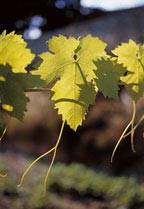
A thousand kilometres further south, in the balmy climate of southern Tenerife, fruity white Viña Peraza is made from grapes grown in the volcanic soils of Spain’s highest vineyards, which climb to 1,700 metres on Mount Teide. Here a long, phylloxera-free past has allowed twenty-seven wine-making grape varieties to survive. Among these, the most widely planted are Listán Blanco and Negro — also known as Palomino elsewhere.
“But the queen is Malvasía,” comments Manuel Manero of the Cumbres de Abona cooperative, which groups the vineyards of 700 growers here. Malvasía is the grape grown organically by 30 of the growers to make Viña Peraza, a fruity aromatic white that won 3rd prize in the 1999 Biofach organic wine awards.
So low are pest levels here, thanks to the year-round sea breezes and long hours of sunshine, that vines are left to grow low, no copper and only occasional sulphur needs to be used in the vineyards. Production depends on rainfall, which can be scanty: this year it is expected to be around 100,000 litres. But the quality of the wine compensates. Next on the agenda is an organic red, which should reach the market within the next five years, and after that the growers will be turning to their lesser known grapes. Given the number of grape varieties and growers, who share an experimental 7-hectare vineyard within a total of 300 hectares, the sky is the limit here.
Old Vines, New Reds
Back in the Mediterranean, growers like Andreu Oliver in Mallorca or the Poboleda coooperative in Priorato are also getting spectacular results by applying careful organic growing and new-generation winemaking to old vines. Both examples spell out the future potential for red wines from very different terroirs.
Andreu Oliver, who runs Ca’n Majoral, a family bodega near Algaida in Mallorca, trained as an industrial engineer but wanted to apply modern agricultural techniques, controlled vinification and fully checked guarantees to the bodega’s wine, which, until 1985, was sold by the barrel.
“The grapes had always been organically grown by my father and grandfather, but uncertified,” comments Andreu. “Now this is a bodega where everything is monitored — from the soil analysis after the harvest to the wine’s fermentation.”
Old vines and native grapes — Callet and Monte Negro for reds, Prensal and Macabeo for whites — still predominate in the 12-hectare vineyard although smaller areas of another half-dozen varieties — Garnacha, Cabernet Sauvignon, Pinot Noir, Merlot, Syrah, Ull de Lebre (Tempranillo) and Reisling — are also planted in smaller quantities. In the damp sea climate, close to sea level, growing techniques are closer to those of the wet north than the dry south. The wines, a blend of first and pressed grape musts, go for varietal fermentation and oak-ageing. Some are varietal. Others, like the cherry-coloured Ull de Llebre, are new-generation blends: in this case of Tempranillo with Syrah, Garnaxa and Callet. Annual production, currently of 30,000 bottles — due to double in the next five years — is sold to Germany within six months of it reaching the market.
And finally, there is the story of Poboleda, a Catalan village in the heart of Priorato’s abrupt slate and schist mountain country. By the mid 1990s, when the world was waking up to the full possibilities of modern wine-making in Priorato’s unique terrain, the fortunes of Poboleda’s oil and wine making cooperative were flagging. As a remedy the cooperative’s younger members launched a joint venture designed to leave members’ capital and land ownership untouched, but to allow them to start realizing the potential of their wines. And here we come full circle. One of the two consulting partners for the joint venture was Josep i María Albet i Noya.

That was back in 1996. Today, just four years later, ten of the cooperative’s largest growers, with 60 hectares of well-established vines between them, are making five different wines from Garnacha, the area’s classic variety, blended with other varieties such as native Cariñena and imported Syrah and Merlot. The grapes, fermented with the stems removed but otherwise left virtually whole on the skins, give very intense musts that are lightly filtered through cellulose. The result is a series of wonderfully aromatic, lightly oaked reds and a white with an average of 14° alcohol and flavor notes running from almond and black fruit to chocolate.
“We were lucky to have old vines,” comments Josep María Riera, the young oenologist in the cooperative. “And conversion to organic growing is very straightforward here.”
Josep María Albet i Noya also has high hopes for the wines. “Things have changed today. We can leap straight up to the quality that we want. We do not have to show the world that we know how to make good wines. They know organic can be among the best.”
Like this page? Please link to us and let the world know!



